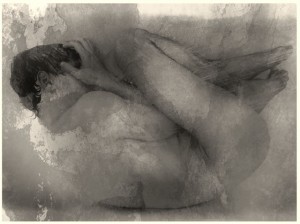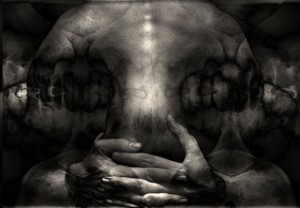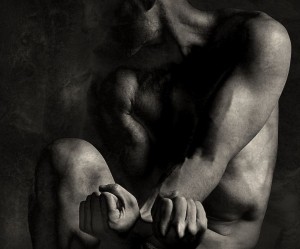Lepers and Me
When I was a child I owned a picture Bible. I am not sure where it came from, as my culturally Jewish family practiced Tibetan Buddhism and eschewed any form of Jewish observance, but I used to pore over its crudely drawn, Disney-like illustrations. As an early act of rebellion, I was a biblical theist from the age of five. I was enthralled by images of a grandfatherly God sitting on a throne in the sky. And I was terrified by a picture of Moses’ sister Miriam. In a full color plate from the book of Numbers, Miriam sits with her skin covered in patchy white flakes of leprosy, hunched over her knees and weeping. She is cold and alone; shut out from the camp where a group of Israelites dance merrily around a campfire that she is barred from joining.
Looking back, I realize that, like many children, I felt inherently estranged much of the time. I was a chubby kid whose family was constantly moving, so I was usually new as well. I was also a weird kid—at the time I was insisting on wearing a silver top hat and tails to school every day. Miriam crouched outside the camp probably resonated with me pretty deeply. As the new weird kid, I felt drawn to the biblical leper—the outsider.
Outside the Camp
Much later, as an adult, I learned the story behind the picture. In the Torah, Miriam and Aaron gossip about Moses’ new wife, Tzipporah. As a punishment, Miriam is stricken with leprosy and sent outside the camp while she is ill. Moses prays for her healing with the words “God please heal her!” (El Na Rafa Na La). These words are held by Jewish tradition to be the original healing prayer.
As usual, God listens, but only halfway. Miriam will be healed, but only after she has paid for her wrongdoing. As God replies to Moses, “If her father spat in her face, would she not bear her shame for seven days?” (Numbers 12:14). In other words, we learn that in tribal Israel, if a father caught a daughter breaking the rules, he would spit on her as a sign of dishonor, and she would have to live with the shame for seven days. Miriam, God’s prophetess, has used her voice for evil (lashon hara) instead of good, and so God explains she must likewise be punished with illness and exclusion.
There is just one problem here. Miriam and Aaron both gossiped. Both had a special relationship to God, as prophet and priest. Why, then, was Miriam the only one sent outside the camp?
The Hebrew word used for outside here is “chutz,” which means both physical and spiritual exclusion. In the world of the Torah, that which is perceived as uncontainable and contagious must be kept chutz (outside) the circle of civilization. In Leviticus we learn that dead bodies; swarming insects; those who are suffering from skin diseases; objects containing certain molds and fungi; and other uncontainable forces of nature convey tumah, impurity, and must be kept outside our sanctuaries and our camps.
Women in the Bible are also connected to tumah. Although men can become impure through seminal emissions, in the biblical world view (and later on through-out Jewish tradition), women are much more likely to be a source of danger and impurity. Women’s impurity is frequent and cyclical, conveyed by their monthly menstrual blood and by their post-natal emissions. In other words, women’s bodies bleed, drip, swell and bloat. They are uncontainable.
Like most women, Miriam already had one toe outside the camp. Unlike Aaron, her body was already the body of an “other.”
We are the Lepers
In the Mishna, the earliest layer of Jewish oral law, we find an echo of the word chutz, outside, as a legal category. In the Mishna those who are chutz are excluded from performing certain mitzvot. For example, in Mishna Hagigah we read: “All are expected by the Torah to bring an appearance offering [i.e. invited to bring a sacrifice to the Temple during pilgrimage holidays] chutz (except) for a deaf mute, a shoteh (one who is insane or developmentally delayed), a minor, a tumtum (one without clearly defined sexual characteristics), an androgynos (one with both male and female sexual characteristics), women, slaves who have not been freed, those with physical impairments, the blind, the old, and one who cannot walk up on foot.” (Mishnah Hagigah 1:1)
To me there is a rich resonance between the way the word chutz is used in the Bible in reference to Miriam being sent outside the camp, and in the Mishna in reference to those who are excluded from appearing at the Temple during pilgrimage holidays. Like Miriam with her horrible skin disease, those who are excluded from this rite are the ones we don’t want to see during our most public holy occasions.
I see myself on this list of people who are excluded. As a gender-ambiguous transgender person, I identify with the tumtum, the person whose sexual characteristics are indeterminate. In my professional life I work as a rabbi at the Bay Area Jewish Healing center and serve people struggling with illness, grief and death, so I also see pretty much all of my clients on this list—the people I serve each day are mentally and physically ill, disabled, and aging. As someone with parents, lovers, community members and friends I also see most of my loved ones here, many of whom are old and many of whom live with chronic disability. And, finally, as a human being I see my future.
Through-out our lives most of us will cycle through illness and health; ability and disability—and all of us will age. We will grow lame and loose; we will lose bits of our memories, eyesight, hearing, skin cells, teeth and inches. I see all of us and all parts of us on this list of outsiders. We are the lepers.
Being in the Image of God is Serious Business
We learn in the book of Genesis that the human being is created btzelem Elohim, in the image of God (Genesis 1:27). Being created in the image of an infinite and incorporeal being is serious business. One of the great contributions of feminist theology has been shattering the illusion that God is the enthroned grandfather from my childhood picture book.
Over and over again, the Torah calls on us to reject idolatry. An idol in biblical times was literally a static divine, a hollow, artificial God. Just as Moses told the Jewish people to destroy the golden calf they had created, Judaism today commands us to smash the dead God of our picture books and to instead choose life through our worship of a living God.
What would it mean to be made in the image of a living God? None of us have static bodies that fit the mold of the normal. Throughout our life we shift and change and grow. We stretch. We shrink. Sometimes, we stink. When I see all of us on the Mishna’s list of the lame and the excluded, I also see the complex and ever-evolving image of God.
I chose to work as a chaplain in part because modern day leper colonies, the homes of those who are most estranged, are the places where God speaks to me the strongest. In hospitals, hospices, nursing homes, and psych units the illness, aging, and fraility that all of us face (or will eventually face) are finally out in the open. This is where life is. These places are holy to me not only because they allow me to help the “other” but because in a very real way, we are the “other.” It is in these places that life feels most alive to me, as this is where the imperfection of humanity is laid bare. No one actually meets the static ideal of “normal” humanity. Each of us will experience illness, grieving and loss. All of us will die and decay.
Our pain, our vulnerability and our wounding, the parts of us that so often remain unspoken and hidden and cut off from our synagogues and shrines, are actually the parts of us that are the most universal. What is on the floor of the hospital, the hospice, the psych unit are the most essential building blocks of the human experience—and of God’s form.
What could be more holy than gooey, oozing, changing, uncontainable humanity? This is what being alive and having a body looks like. This is the image of God.
![[the current issue of ZEEK]](../../image/2/100/0/5/uploads/leftistethicistgraphic-52842c6a.png)
- 5000 Pages of Zeek
- Founded in 2001, Zeek was the first Jewish online magazine, and we have over 5000 pages online to prove it, all available free of charge. Read more in the Archive.
More articles in
Faith and Practice
- To-Do List for the Social Justice Movement: Cultivate Compassion, Emphasize Connections & Mourn Losses (Don’t Just Celebrate Triumphs)
- Inside the Looking Glass: Writing My Way Through Two Very Different Jewish Journeys
- What Is Mine? Finding Humbleness, Not Entitlement, in Shmita
- Engaging With the Days of Awe: A Personal Writing Ritual in Five Questions
- The Internet Confessional Goes to the Goats




